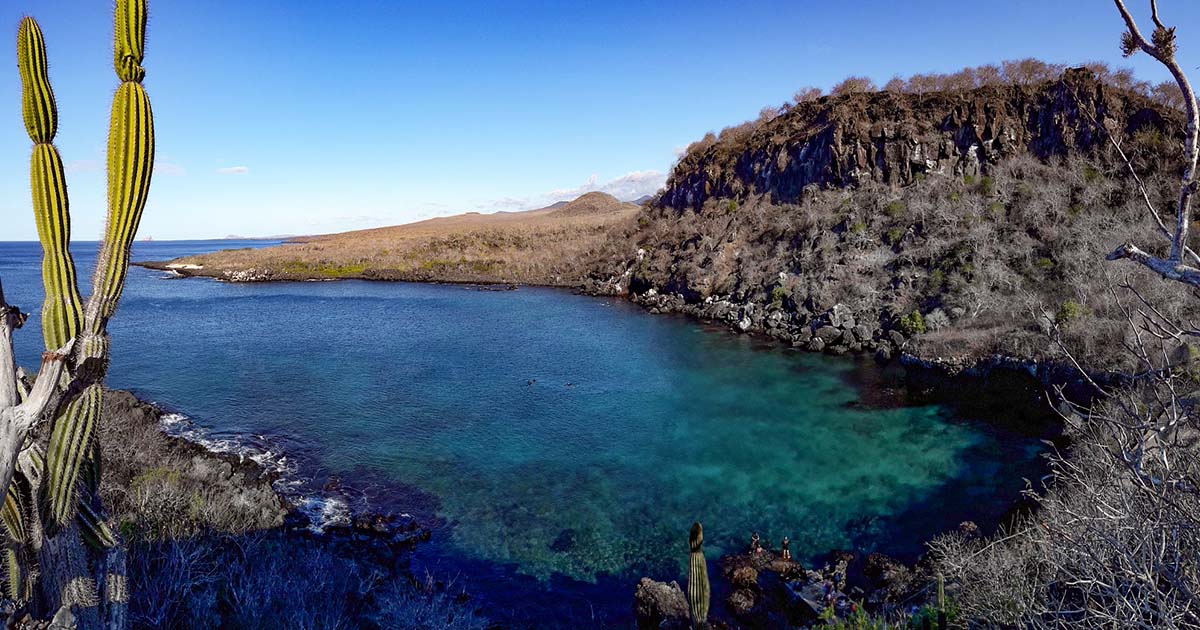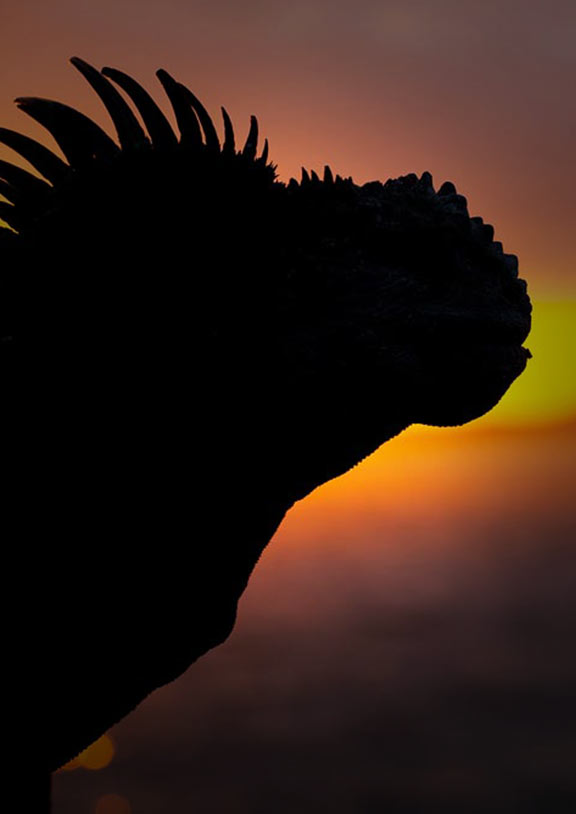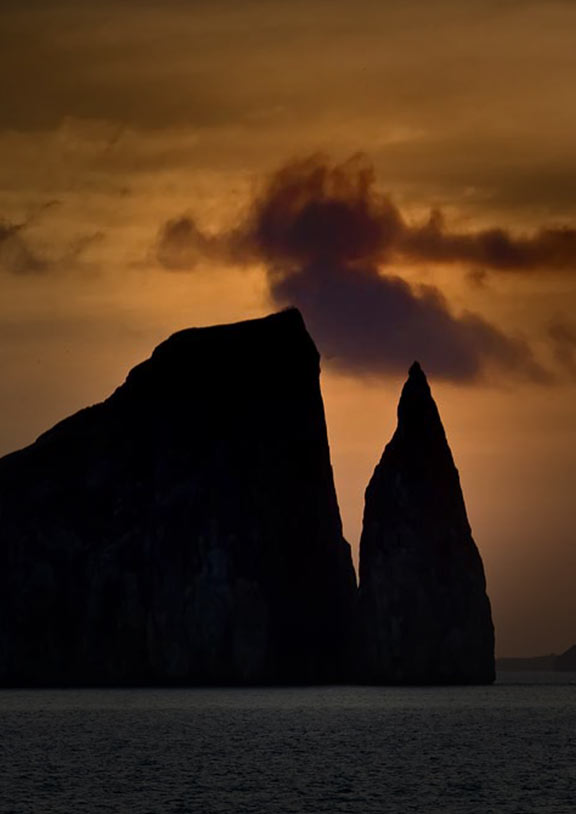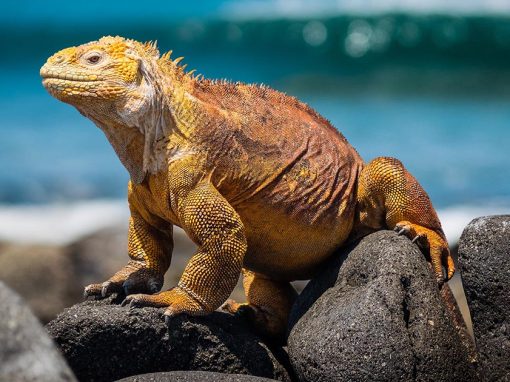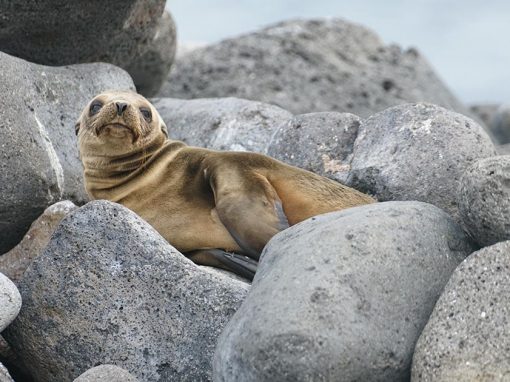San Cristobal Island, or Isla San Cristóbal, is one of the oldest of the Galapagos Islands at about 2.4-4 million years old. It is actually also the Galapagos Islands capital. Around 600 miles off the coast of Ecuador, it is the easternmost of all the islands. Being the nearest to South America, it makes sense that it is also the first island that naturalist/biologist Charles Darwin stepped foot on. The island is volcanic in composition, made up of extinct volcanoes that have fused together. Travelers from near and far visit ancient San Cristobal for the flora and fauna of its famous beaches and lagoons. It’s also one of the best spots in the Galapagos for scuba diving.
San Cristobal Island History
Geography
Climate and Weather
Best Time to Visit
Getting to San Cristobal
Points of Interest
Wildlife
Things to Do
Hotels
Restaurants
Safety Tips
Rules
Packing List
Your Trip
San Cristobal Island History
The island of San Cristobal has a rich and fascinating history. It is actually home to the oldest permanent settlement of the Galapagos Islands, plus it is the very first island that Darwin visited in 1835 aboard the HMS Beagle. Less than 50 years later, in 1880, an exile colony was built for prisoners coming from mainland Ecuador. With time, this colony was transformed into a military base and later became the islands’ primary export center for sugar, coffee, cassava, cattle, fish and lime. Today, the main industries of the island are government, tourism and fishing.
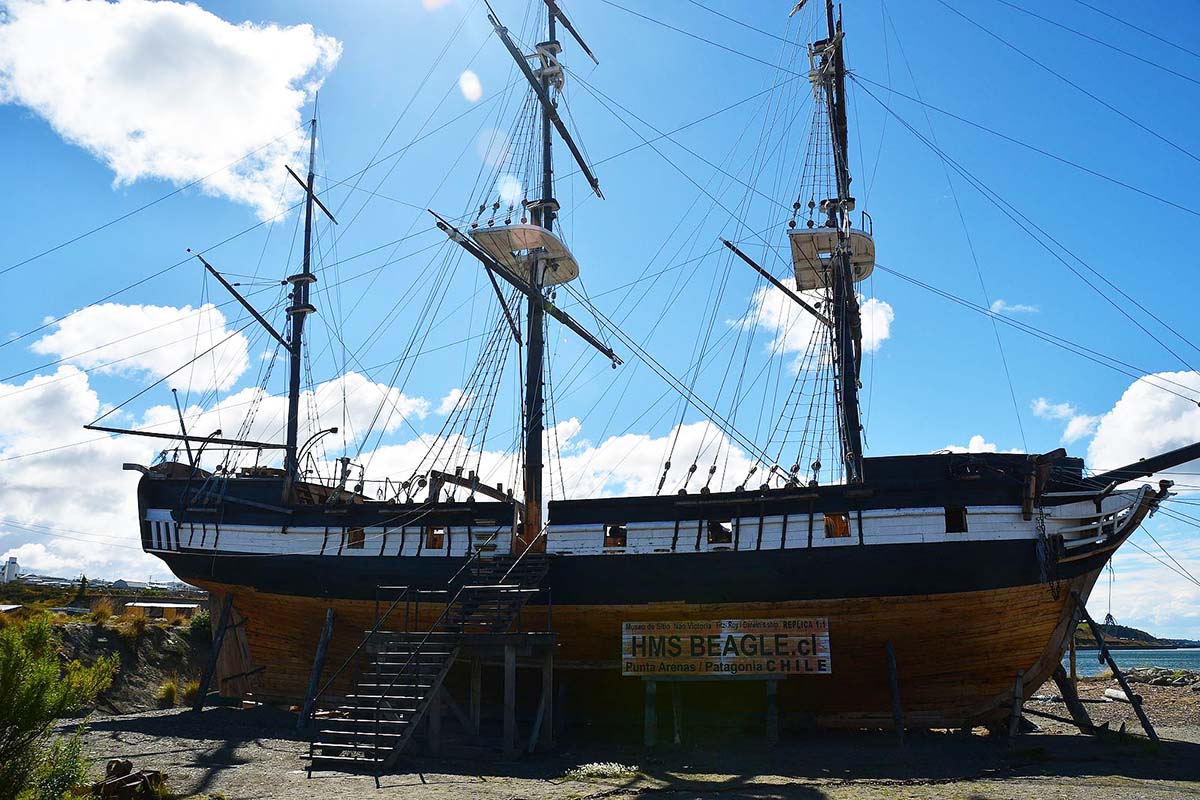
Replica of the HMS Beagle, the ship that Charles Darwin rode on his research expedition to the Galapagos Islands. Image: 0170219-Punta Arenas-0022 ” by S p-hunter, used under CC BY-SA 4.0 / Compressed from original.
Geography
San Cristobal, along with Santa Fe and Espanola Islands are the oldest of the Galapagos geologically. San Cristobal is a volcanic island made up of three or four extinct fused volcanoes. The latest eruptions were in prehistoric times, but likely no more than 1,000 years ago. The land to the west of the island is older than the eastern side where relatively young lava flows can be found. The island itself spans about 215 square miles and the highest point reaches 2,400 feet. It is the most fertile of all the islands, and the western portion especially is densely vegetated. Puerto Baquerizo Moreno is the capital of San Cristobal and is located at the southwest tip.
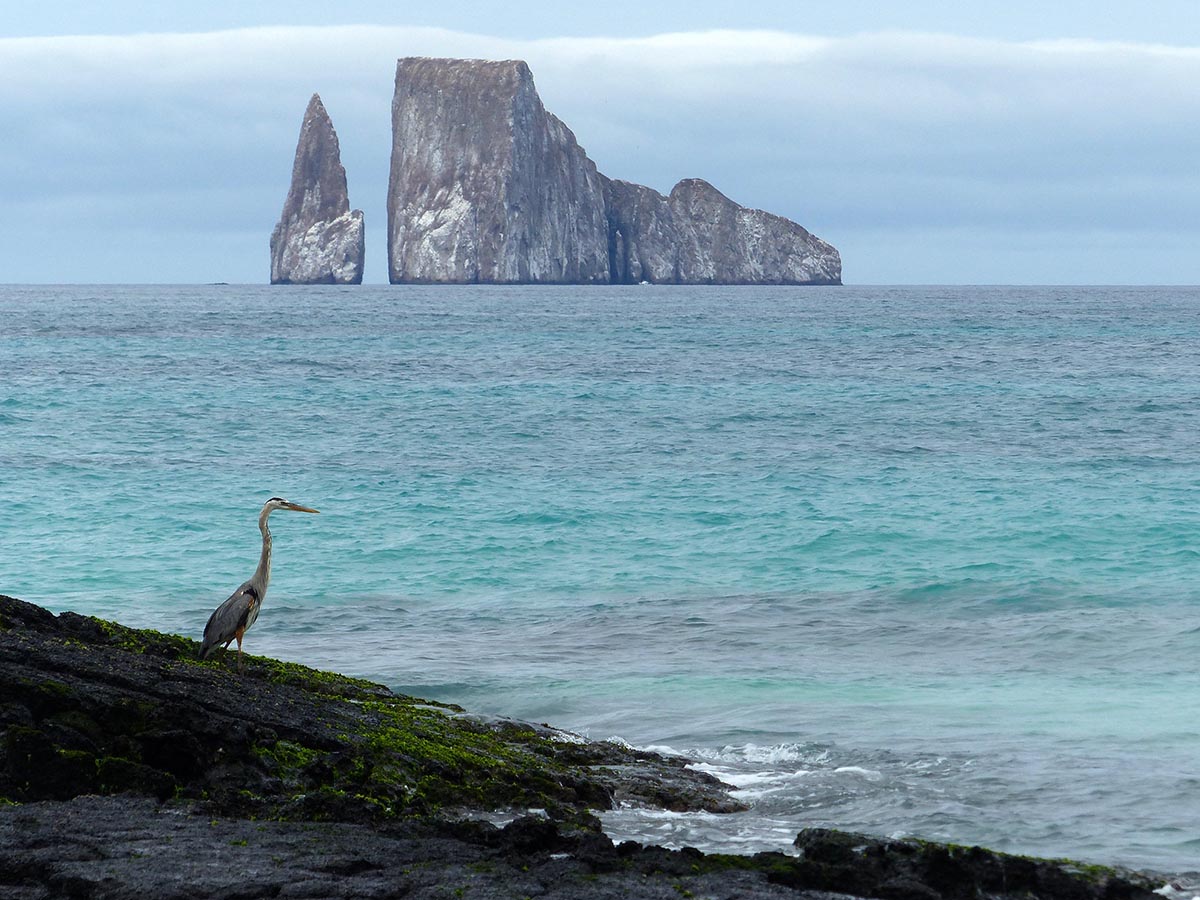
Kicker Rock, also Known as Leon Dormido or Sleeping Lion, just off the coast of San Cristobal. Image: Cerro Brujo Galapagos 9” by John Crane, used under CC BY 2.0 / Compressed from original.
Climate & Weather
The Galapagos have a fairly moderate and stable temperature year round with an average of 75-80 degrees Fahrenheit. The weather in San Cristobal, Galapagos is pleasant all 12 months and even at the highest point it doesn’t get very cold. The main variation in weather throughout the year is that there is a warmer wet season from January to June, and a cooler dry season from July to December.
The wet season sees higher temperatures (low to mid 80s), and there can be some cloudy days with showers that pass quickly. The dry season has slightly lower temperatures (mid to high 70s), more blue skies and less precipitation. However, there is a phenomenon known as garua in Spanish, characterized by occasional grey, misty weather. It is caused by the chilly Humboldt Current and occasionally affects San Cristobal Island this time of year.
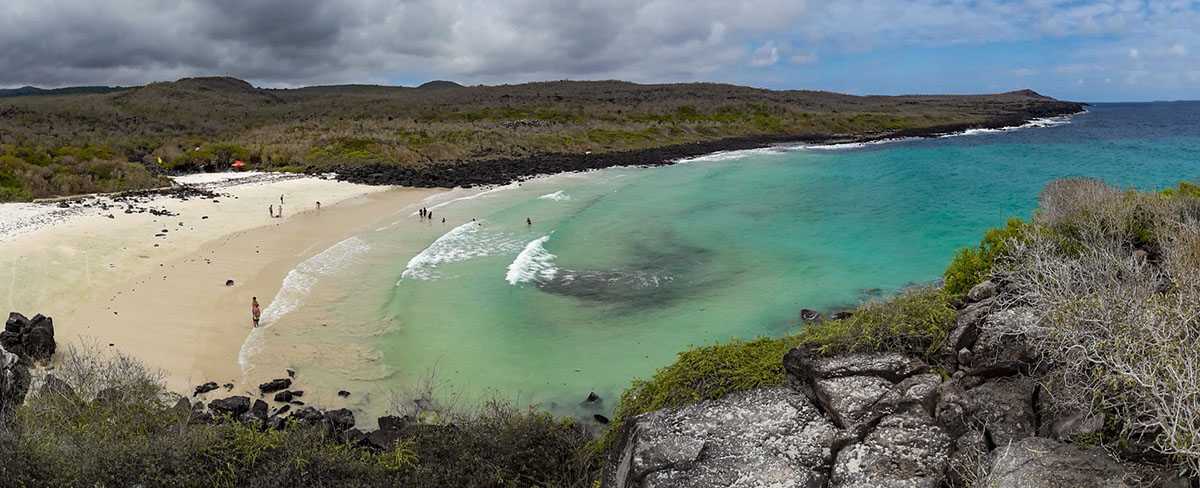
The inviting waters of Puerto Chino Beach, located 15 miles from town. mage: Puerto Chino” by David Ceballos, used under CC BY 2.0 /Cropped and compressed from original.
Best Time to Visit
San Cristobal Island is a year-round destination, so any time of year is a great time to visit. The best time really depends more on your interests and what specific animals that you’d like to see. That being said, you can see amazing wildlife any time you go. Overall, January-July is the best time to visit San Cristobal and the Galapagos. This is because you will experience calmer waters and therefore better visibility. As a result, there is also a reduced risk of seasickness and increased possibility of seeing more sea life when you snorkel or scuba. In addition, right at the beginning of the year the green sea turtles hatch their eggs, making this a very popular time to come. In March on San Cristobal the frigatebirds begin their mating season, along with other land birds, sea lions, turtles and tortoises across the archipelago.
The second half of the year, August-December, is still an excellent time, but with some rougher waters making sea birds and penguins more active searching for food. In December is when the giant tortoises start hatching their eggs.
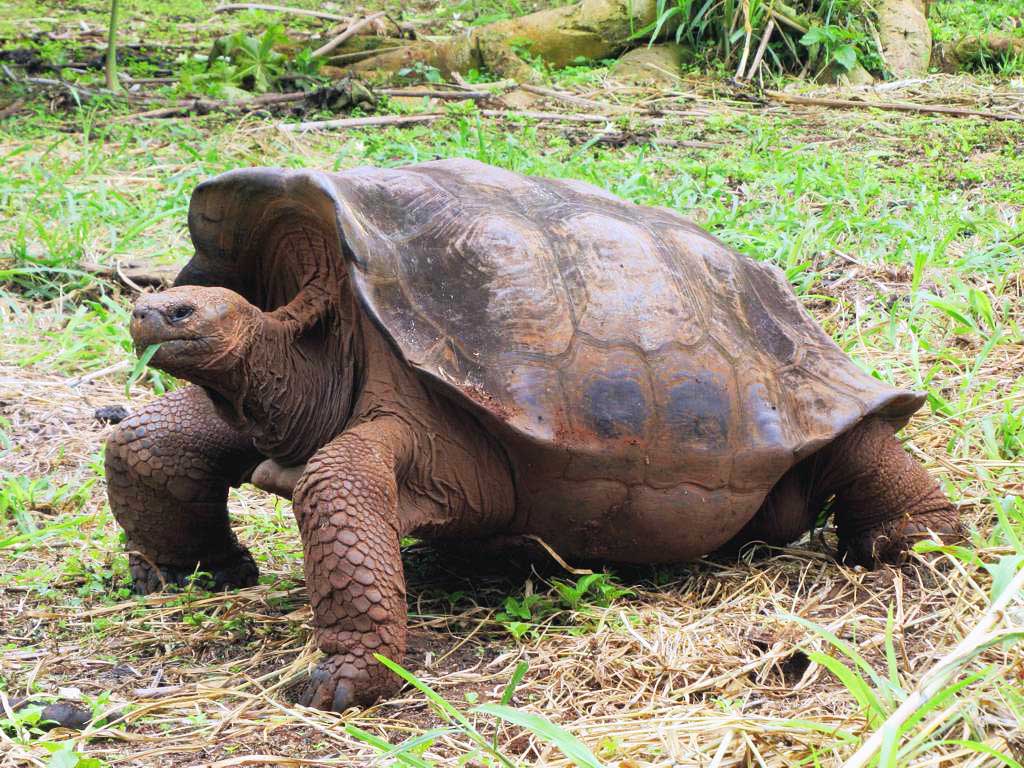
Galapagos giant tortoise can be found on San Cristobal Island. Image: Giant Tortoise” by David Stanley, used under CC BY 2.0 / Compressed from original.
Getting to San Cristobal
Visitors may fly direct to San Cristobal island from the cities of Quito (Mariscal Sucre Airport) or Guayaquil (José Joaquín Olmedo Airport). If flying from Quito, there will be a stopover in Guayaquil, making the journey more lengthy; but you will be able to stay on the plane for this stop. Once you arrive at San Cristobal airport, you can catch a taxi or your travel agent can arrange transportation prior that will take you to Puerto Baquerizo Moreno. This is the primary city of the island, and the hub for shopping, dining and lodging.
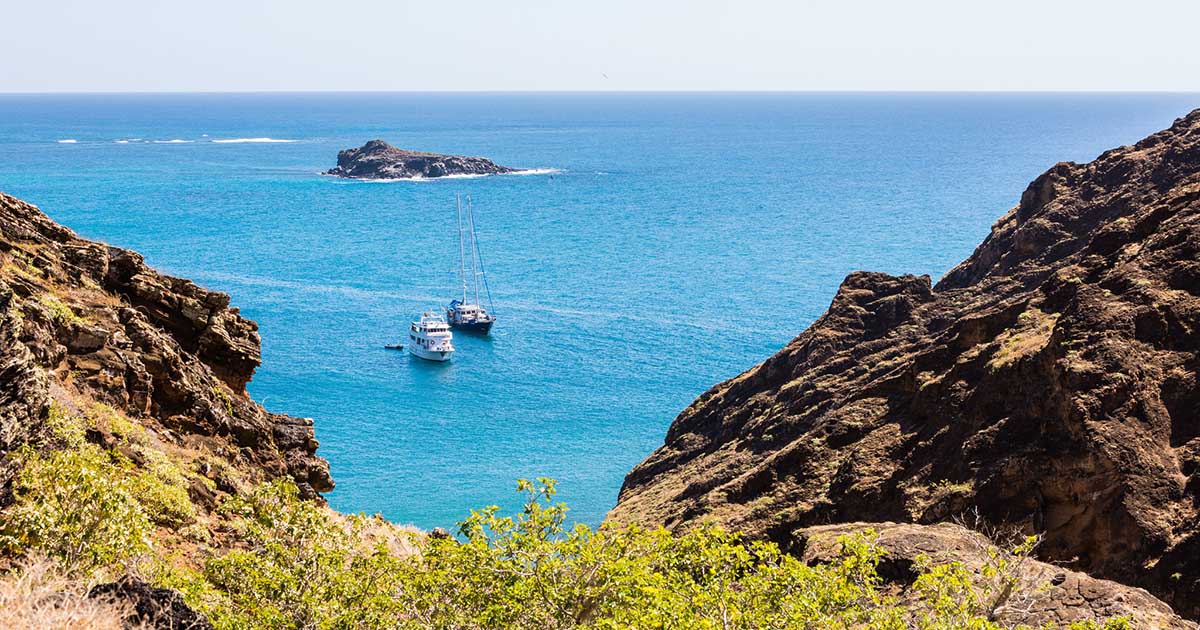
Ships en route to San Cristobal Island. Image: Paisaje_en_Punta_Pitt,_isla_de_San_Cristóbal,_islas_Galápagos,_Ecuador,_2015-07-24,_DD_76” by Diego Delso, used under CC BY-SA 2.0 / Compressed from original.
Points of Interest
Puerto Baquerizo Moreno
Puerto Baquerizo Moreno is the capital of the Galapagos Islands. It is a hub for waterfront hotels, restaurants and dining. Here there is an interpretation center, Galapagos National Park and a natural history museum. This is also the launch point for most activities out at sea or on land.
Kicker Rock / León Dormido
Kicker Rock, also known as Sleeping Lion or Leon Dormido in Spanish is two cliff-like rocks jetting 500 feet out of the Pacific off the west coast of San Cristobal Island. It gets its name because the island physically looks like a sleeping lion or a boot depending what side you approach it from. This is one of the most popular areas in the Galapagos for wildlife viewing and snorkeling. It is also a great dive site. This area is bursting with sea life and bird life. The hammerhead sharks are a main draw in terms of wildlife viewing.
Lobos Island
6 miles north of San Cristobal you find Lobos Island, a small islet known for its sea lion population. Here you can snorkel alongside sea lions, take a short half-mile hike around the island or relax on the white sand beach. There are also some dive opportunities.
El Junco Lagoon
El Junco Lagoon is an otherworldly volcanic lake located in the highlands of San Cristobal Island. It’s the only freshwater lake of the island, and is an excellent place to spot pintail ducks, frigate birds and common gallinules. It gets its name from an endemic sedge plant that grows at the shores of the lake.

El Junco lagoon, the only fresh water source on San Cristobal Island. Image: Lac de cratère d’El Junco (700 m) – Volcan des Galapagos, San Cristobal” by Florent Figon, used under CC BY-SA 2.0 / Cropped and compressed from original.
Pitt Point / Pitt Islet
Pitt Point is a fascinating spot for bird watching at the northeast side of the island. This is actually a nesting site for birds, and you can find all three types of boobies here – the blue-footed, red-footed and Nazca – among many other types of birds. Other activities of the island include walking, swimming and snorkeling.
Witch Hill/Cerro Brujo
Witch Hill or Cerro Brujo in Spanish is one of the best beaches in all of the Galapagos. The white coral sand beach is a great place to relax, snorkel and catch a glimpse of marine and bird life. It’s also a geologically interesting spot, and the hill of the island is the remains of a volcanic tuff cone.
Interpretation Center
The San Cristobal Interpretation Center, located in Puerto Baquerizo Moreno, is an excellent place to learn about the natural history, human history and conservation efforts of the island. It’s located just a short walk from town, and features exhibits with maps, photos and information as well as paved and gravel trails with flora and fauna. This is the most comprehensive interpretation center in all of the Galapagos, so make sure to stop by to get some deep geological, conservational and historical context about the islands.
La Galapaguera/Jacinto Gordillo Tortoise Breeding Center
This is a relatively new visitor site, opened in 2003, and is located about one hour from Puerto Baquerizo Moreno by car. At the breeding center, you will have an opportunity to see giant tortoises and hatchlings, and learn about the origins and evolutions of these amazing animals. Plus, you will learn about modern day threats and what the center is doing to combat them.
Ochoa Beach
Ochoa Beach is 30 minutes from Puerto Baquerizo Moreno by boat. It is a horseshoe-shaped cove that features a white sand beach and plenty of wildlife. Visitors can relax on the sand scanning the land and air for sea lions, blue-footed boobies, pelicans and frigate birds. Many people also take advantage of the shallow waters to snorkel or kayak.
La Loberia Beach
This beach is popular for surfing, lounging, hiking, viewing wildlife (especially sea lions) and snorkeling. It is located just 10 minutes from the San Cristobal airport and features beautiful coral sand beaches. The trails on the beach pass by some amazing vegetation of the island, like button mangrove, white mangrove, palo santo, Galapagos cotton, Tiquilia and more.
Frigatebird Hill / Cerro Tijeretas
Cerro Tijeretas, or Frigatebird Hill in english, gets its name because it is a nesting spot for two species of frigatebirds. It is a popular hiking spot, and it takes about 45 minutes by foot to reach the top of the hill from Puerto Baquerizo Moreno. At the top, you’ll enjoy sweeping views of Wreck Bay and Kicker Rock. At the base of the hill, there is a nice spot for swimming and snorkeling where you may catch a glimpse of sea lions and tropical fish.
Puerto Chino Beach
Yet another crystal clear white sand beach of San Cristobal Island, located about 15 miles from Puerto Baquerizo Moreno. Here, like many other Galapagos beaches, is just the perfect spot for a relaxing beach day in the midst of all your exploring. Chill on the sand, dip your toes in the crystal blue waters or explore the mangroves for Darwin’s finches.
Punta Carola Beach
This beach is conveniently located just a 10 minute walk from the town of Puerto Baquerizo Moreno. It’s one of the best beaches for relaxation and quality time reflecting on the wonders of the Galapagos with your fellow travelers. Though quick and easy to get to, it is a relatively secluded area where you can see sea lions, seagulls, lizards and turtles. Snorkeling and swimming are the best ways to enjoy the area.
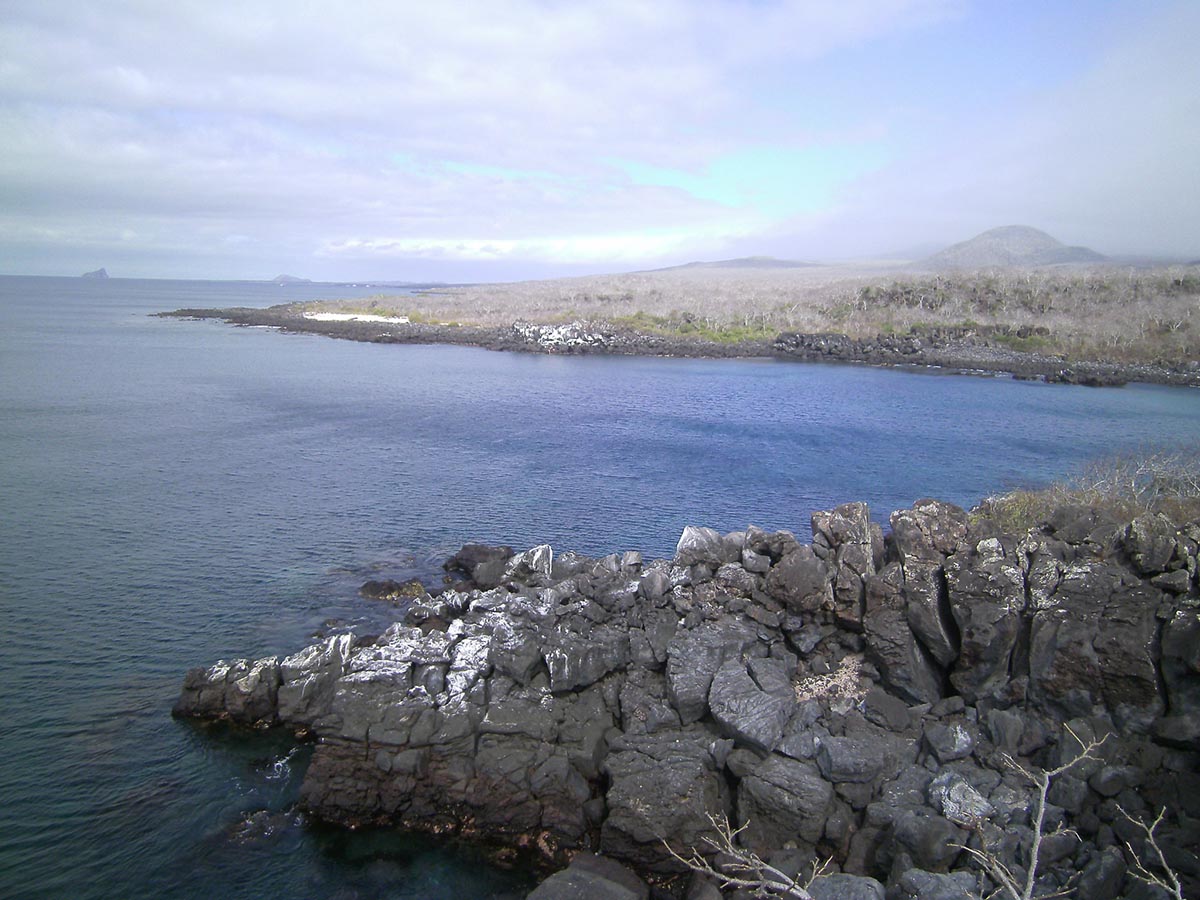
Punta Carola Beach of San Cristobal Island. Image: Punta Carola” by Danielle Golon, used under CC BY 2.0 / Compressed from original.
Wildlife
The fascinating wildlife of the San Cristobal and the Galapagos as a whole is arguably the main reason people come to visit the islands. The animals are very friendly and have no natural fear of humans, so you can enjoy these curious creatures from close up. However, to preserve the vitality and comfort of the animals, do not touch them and be sure to maintain a 6-foot distance at all times.
In the Sea
There are many aquatic and semi-aquatic animals that enjoy the pristine and peaceful waters of the Galapagos. Among them are Galapagos sea lions, Galapagos fur seals, minke whales, orcas, humpback whales, dolphins, Galapagos green sea turtles, marine iguanas, Sally lightfoot crabs, ghost crabs, hermit crabs, whale sharks, Blainville’s beaked whale, Cuvier’s beaked whale, as well as an abundance of tropical and reef fish.
On Land
On land you can find many interesting reptiles and insects. Reptiles include the famous Galapagos giant tortoises, lava lizards, Galapagos land iguana and Galapagos pink land iguana. Insects include eight species of butterflies, praying mantis, beetles, bees and more. There are also some arthropods including the Galapagos scorpion and common yellow scorpion.
In the Air
The birdlife of the Galapagos is infamous, from Darwin’s finches to blue-footed boobies. Other interesting birds you can find on Cristobal Island include red-footed and Nazca boobies, frigate birds, brown pelicans, tropic birds, Galapagos hawk, peregrine falcon, and mockingbirds.
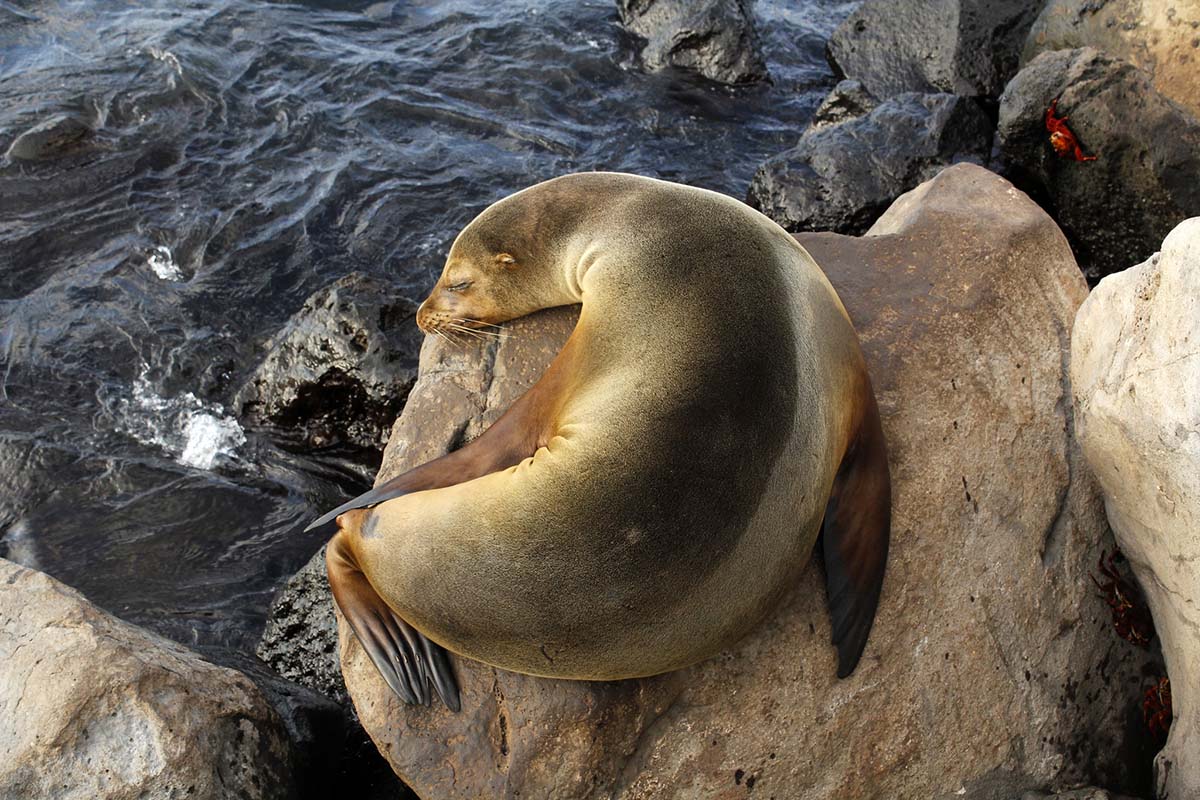
A sea lion resting on San Cristobal Island. Image: San Cristóbal, Galápagos” by descubriendoelmundo, used under CC BY-SA 2.0 / Compressed from original.
Things to Do
Snorkel
Snorkeling on San Cristobal Island is one of the best and easiest ways to maximize your time in the Galapagos and see as much wildlife as possible. While the animals on land are exciting to see, you really get the full picture of the unique diversity of the islands when you take a peek below the ocean’s surface. Great snorkel spots include Kicker Rock, Lobos Island, Pitt Point, Witch Hill, Ochoa Beach and Punta Carola Beach. Kicker rock snorkeling is some of the most popular in all the Galapagos. Prepare to be amazed when you spot sea lions, sea turtles, star fish, king angelfish, Pacific seahorses and a variety of colorful reef fish.
Hike
Stroll the island by foot for some cardio matched with unforgettable wildlife encounters. The most popular hikes include Cerro Tijeretas or Frigatebird Hill. Here you can take a brisk 45-minute walk up the hill to a gorgeous 360 degree vantage point of the surrounding land and sea. You can also hike around Lobos Island, enjoy the trails of the Interpretation Center and mount the hills of Darwin’s Cove. Keep your eyes peeled for frigatebirds, sea lions and more.
Scuba Dive
If you want an even deeper experience of this majestic island, dive to the vibrant ocean floors on a scuba diving tour. During your scuba experience, you will have a chance to catch a glimpse of sea turtles, marine iguanas, sea lions and all kinds of colorful reef fish. Kicker Rock is a good spot for intermediate divers while Lobos Islands is great for beginners.
Surf
The beaches to the northwest coast of San Cristobal Island are the best spots for good waves. Particularly La Loberia for beginners and Tonga Reef for experienced surfers are the most popular. Punta Carola beach is another good spot to catch some great waves from November to April, just a 15 minute walk from Puerto Baquerizo Moreno. El Manglecito is a nice surf spot too, and as a bonus you can spot iguanas and sea lions on the beach.
View Wildlife
If you are wondering where to see wildlife on San Cristobal Island, the answer is: just about everywhere. In Puerto Baquerizo Moreno, the capital city and main touristic center, you can see sea lions, pelicans and blue-footed boobies. At La Loberia beach, you may spot sea lions, marine iguanas and many types of birds. At Cerro Tijeretas you can spot frigatebirds on the hill or marine iguanas, sea turtles, sea lions and many fish down below in Darwin’s Bay. Kicker Rock is a famous wildlife viewing area, replete with frigatebirds, boobies, sea turtles and, most famously, hammerhead sharks. Punta Point is the most famous spot to see all three species of boobies (red-footed, blue-footed and Nazca). Finally, La Galapaguera is the best spot to see giant Galapagos tortoises.
Relax at the Beach
Reward yourself after all the diving, hiking and exploration with a day of deep relaxation on one of San Cristobal’s beautiful beaches. The best spots to sunbathe and swim include Ochoa Beach, Witch Hill, Puerto Chino Beach or Punta Carola Beach. Don’t forget to bring your sunscreen and be sure to keep your eyes peeled for wildlife.
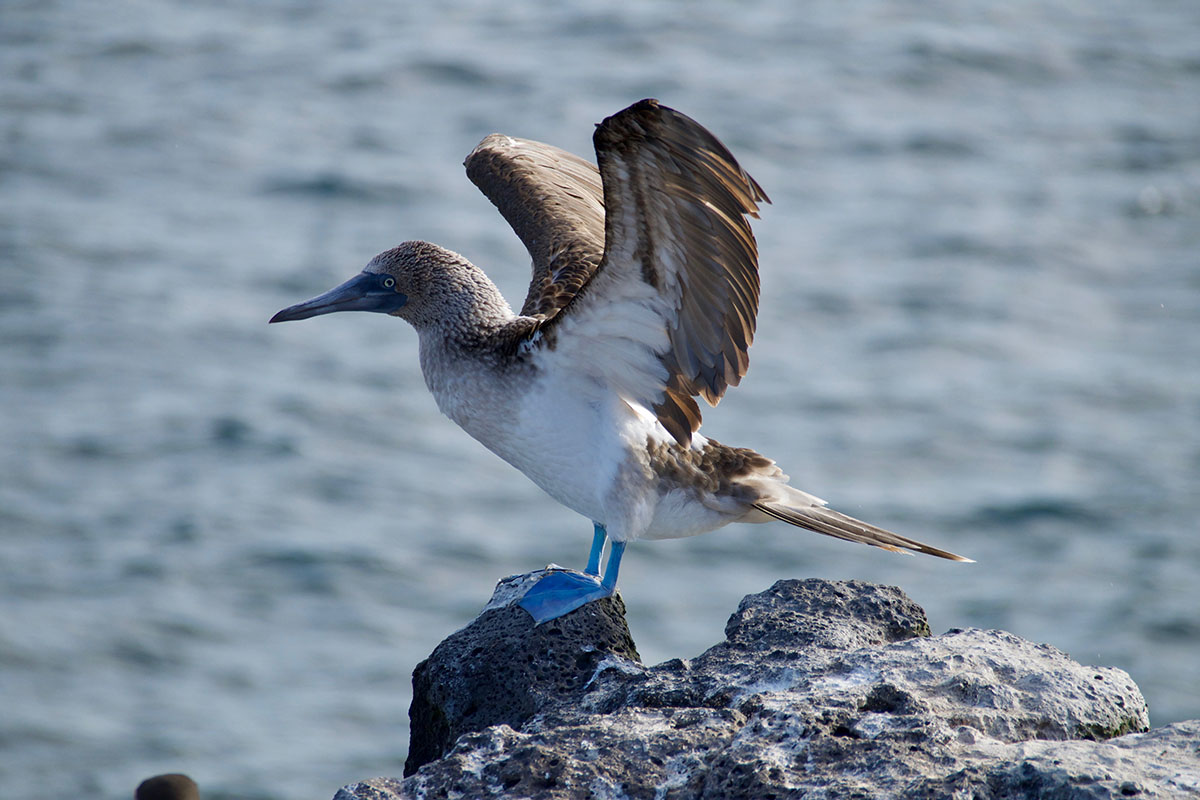
The famous blue-footed boobie. Image: Andy Brunner on Unsplash.
San Cristobal Island Hotels
There are many excellent spots for lodging in San Cristobal Galapagos. From artsy hideaways to luxury waterfront escapes, all the options are conveniently located in the capital city of Puerto Baquerizo.
Eco Hotel Katarma | 3 star
Environmentally-friendly, artistic hotel with pool, bar, spa, game room and common areas for relaxing.
Address: Calle Esmeraldas and Ave Alsacio Northia, Puerto Baquerizo Moreno, Ecuador
Casa Blanca | 3 star
A charming, artsy bed and breakfast just off the pier with ocean views, complimentary breakfast, local artisan market and more.
Address: Av. Charles Darwin y Herman Melville, Puerto Baquerizo Moreno, Ecuador
Sea Side Inn San Cristobal | 4 star
Comfortable hotel just 2 minute walk to Playa Mann Beach with ocean views, balconies, swimming pools, jacuzzi, minibar and more.
Address: Via Playa Mann, San Cristobal, Ecuador
Galapagos Sunset Hotel | 4 star
Across from the tourist pier is this contemporary hotel with sea views, rooftop terrace and easy access to popular dining and shopping.
Address: Av. Charles Darwin Herman Melville, Puerto Baquerizo Moreno, Ecuador
Golden Bay Galapagos Hotel and Spa | 5 star
This elegant and polished hotel is located directly on the Playa de Oros (Beach of Gold) with sea views, pool, wildlife viewing, sun terraces, and bar and lounge.
Address: Calle Charles Darwin Lote 3, Sector Playa de Oro, Puerto Baquerizo Moreno, Ecuador
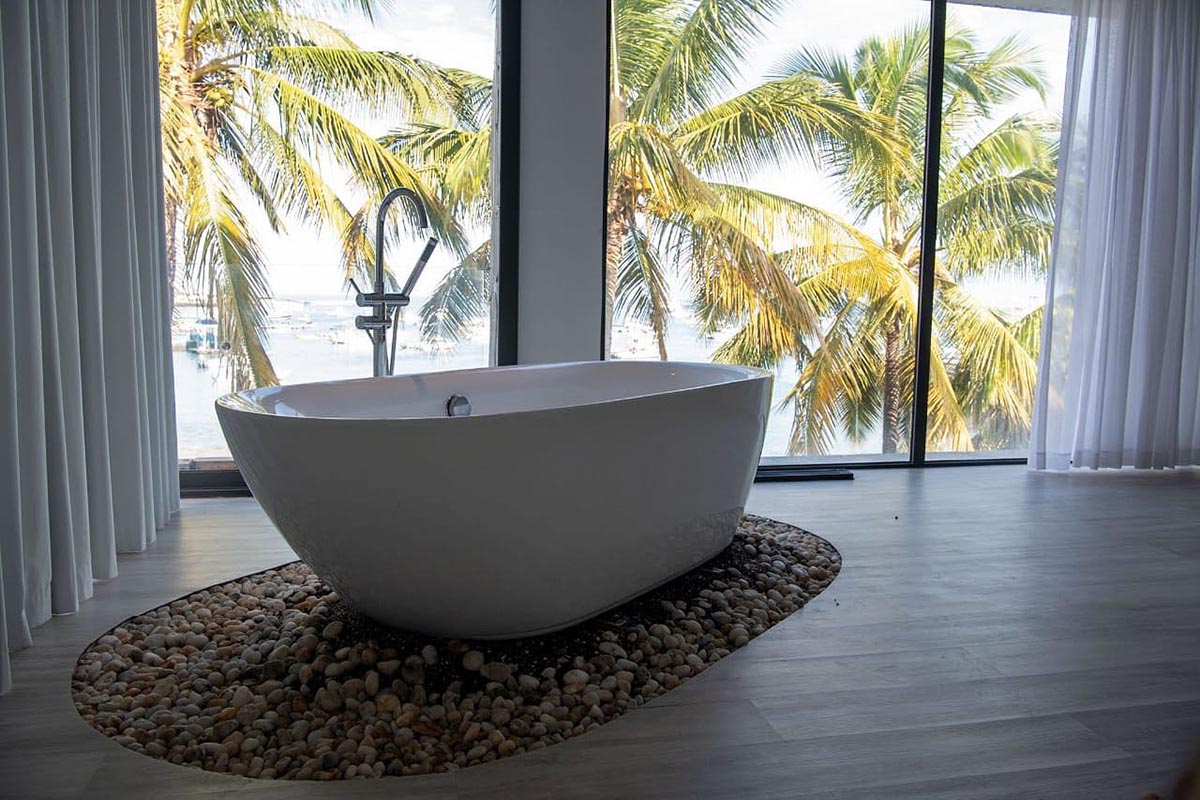
Bath at Golden Bay Hotel of San Cristobal. Image: Golden Bay Hotel Facebook Page.
Restaurants
Browse below for some of the best restaurants in San Cristobal Galapagos.
Muyu Galapagos | $$-$$$
Contemporary, Healthy, Vegan, Vegetarian and Gluten-Free Options
Address: Charles Darwin 3 In front of Golden Beach, Puerto Baquerizo Moreno, Ecuador
El Descanso Marinero | $$-$$$
Latin, Seafood, Ecuadorian, Vegetarian Options
Address: Calle Alsacio Northia y Espanola, Puerto Baquerizo Moreno, Ecuador
Fresco Cafe | $
International, Mediterranean, Middle Eastern, Vegan, Vegetarian and Gluten-Free Options
Address: Waterfront and Manuel Agama Playa de Oro, Puerto Baquerizo Moreno, Ecuador
Giuseppe’s Restaurant | $$-$$$
Italian, Pizza, Seafood, Mediterranean, Vegan, Vegetarian, and Gluten-Free Options
Address: Av. Charles Darwin y Manuel J. Cobos Diagonal, Ecuador
Otoy Restaurant Organic Farms | $$-$$$
Seafood, South American, Soups, Vegan, Vegetarian, and Gluten-Free Options
Address: Cerro Verde, Carretera Principal Via a la Galapagera y Puerto Chino, Ecuador
Cri’s Burgers | $
Fast Food, American
Address: Teodoro Wolf, Puerto Baquerizo Moreno, Ecuador
Sabor Cuencano Cafe | $
Bakery, Coffee Shop
Address: Av. Alsacio Northia s/n Federico Garcia, Puerto Baquerizo Moreno, Ecuador
Midori Sushi | $$-$$$
Japanese, Ecuadorian, Seafood, Asian, Vegetarian Option
Address: Igancio Hernandez, Puerto Baquerizo Moreno 200150 Ecuador
Lucky’s | $
Ecuadorian, South American, Soups
Address: Corner of Ignacio Hernandez y Villamil, Puerto Baquerizo Moreno, Ecuador
Maui Restobar | $$-$$$
Bar, Pub
Address: Av. Armada Nacional, Ecuador
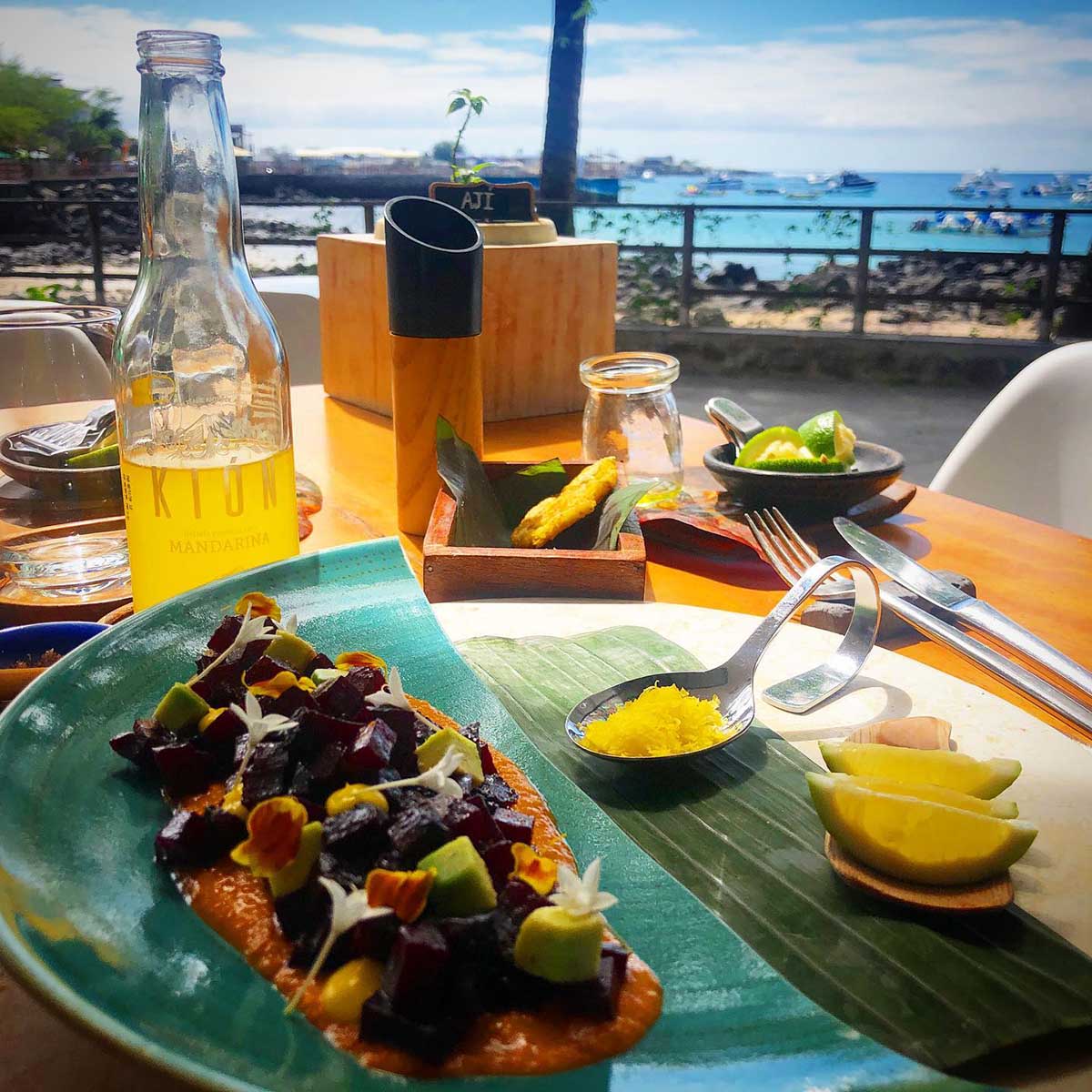
Healthy food options and great views at Muyu Restaurant. Image: Muyu Restaurant Facebook.
Safety Tips
The Galapagos are very safe tourist destinations, even moreso than mainland Ecuador which itself is relatively safe. However, like anywhere else in the world there are ways to keep you and your loved ones free from harm:
- Keep your personal belongings secure. Tho petty crime is uncommon, it is always good to keep your valuables in a safe place.
- Protect yourself from the sun. Avoid burning by wearing plenty of sunscreen and covering with a hat for comfort.
- Stay hydrated. Be sure to drink plenty of water throughout the day and always bring a bottle of water on hikes.
- Stay on the trails. This is not a suggestion, it is mandatory. This helps protect the delicate ecosystem of the islands plus it helps protect you from getting lost or traversing into dangerous/unsteady territory.
- Be aware of wildlife. Be sure to always keep distance from all wildlife, especially male sea lions and sharks.
- Practice safe swimming. Whether swimming, diving or snorkeling, be sure to follow the safety tips outlined by your guide.
Rules
More than a tourist destination, the Galapagos Islands are natural sanctuaries for the amazing animals and plants that live there. It is therefore of utmost importance that you respect the flora and fauna of San Cristobal for the entirety of your stay. Rules and regulations on San Cristobal, Galapagos National Park, and throughout the islands include:
- Follow and always stay on the marked trail.
- Do not touch or approach the animals
- Maintain at least six feet of distance from the animals at all times.
- Do not take any rocks, shells, plants or other items from the islands.
- No littering.
- Do not smoke.
- No fishing in Galapagos National Park
- When in Galapagos National Park, listen and adhere to all instruction from your guide. They are the ultimate authority and know the islands’ geology, wildlife, and plantlife through and through.
If you see anyone violating these rules, notify a guide or other official immediately.
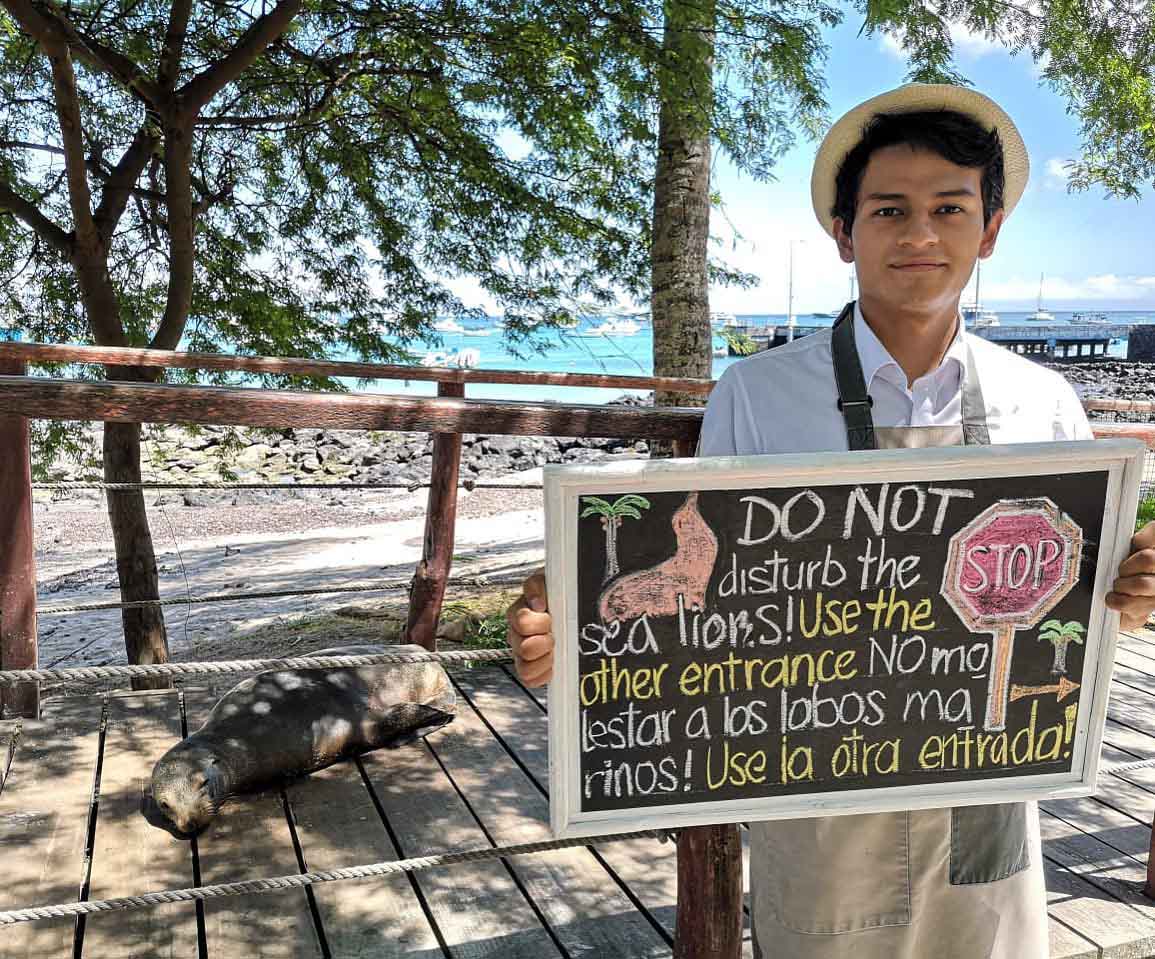
Image: Muyu Restaurant Facebook Page.
Packing List
- Footwear. Sneakers or hiking boots, waterproof shoes with toe protection, and sandals or other casual shoes.
- Clothing. Shorts, lightweight pants, long and short-sleeved lightweight shirts, bathing suit, casual clothing like shorts and t-shirt and sundresses, sweater or light jacket for evenings, rain jacket if wet season, socks, underwear.
- Accessories: Wide-brimmed hat, sun glasses, small waterproof bag
- Personal care: Sunscreen, insect repellent, toiletries,
- Personal items: Water bottle, binoculars, flashlight, book or kindle, lightweight day pack for tours and hikes.
- Snorkel and scuba. All scuba and snorkel gear can be rented on the island. However, you may want to bring your own wetsuit to ensure comfortable fit. It’s also a good idea to bring your own goggles, especially if they are prescription.
- Electronics. Camera, memory cards, batteries, underwater camera, phone, chargers
- Medicine. Seasick tablets, patches or wristbands, antibiotics and any other prescription medications you need.
Read a more detailed packing list here.
Your Trip to San Cristobal Island, Galapagos
A visit to San Cristobal is one of the best things to do in the Galapagos. Whether taking a hike, relaxing on white sand beaches, deep diving off Kicker Rock, or observing sea lions and blue-footed boobies, it will be an unforgettable stop on your Galapagos Island journey. However, Trips to the Galapagos (and specially cruises), tend to sell out well ahead of time so be sure to book your trip 5+ months in advance!
Contact a travel advisor today to book your Galapagos cruise or island-hopping tour. They will be sure to include all the best that San Cristobal Island has to offer.

Latin America for Less is a group of travel experts who live, work, eat, and breathe all things South America. Their inspiration stems from a deep appreciation for the beauty and diversity that make this continent so special.

